1993 CADILLAC FLEETWOOD manual transmission
[x] Cancel search: manual transmissionPage 7 of 386
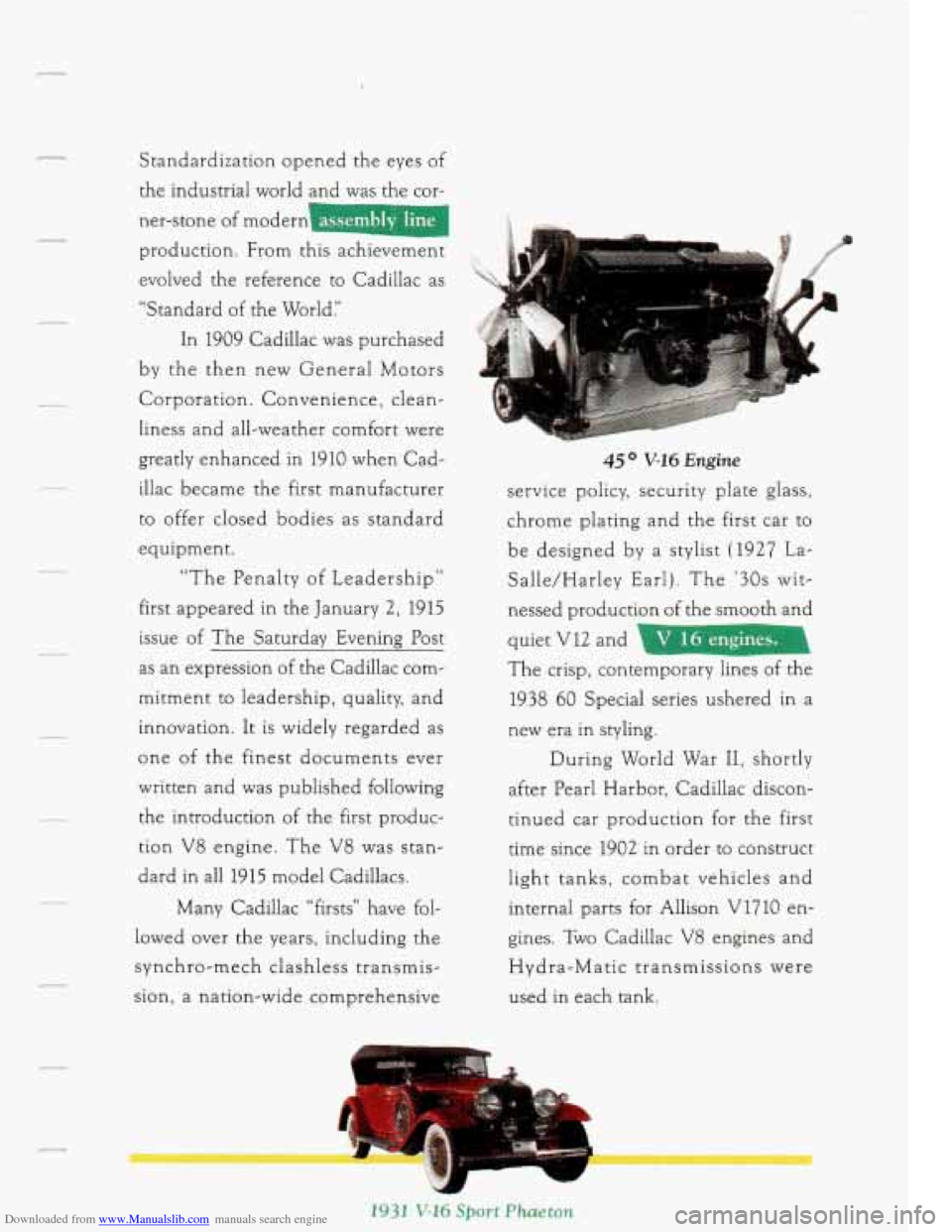
Downloaded from www.Manualslib.com manuals search engine Standardization opened the eyes of
the industrial world and was the cor-
ner-stone of modern
production. From this achievement
evolved the reference to Cadillac as
“Standard of the World.”
In
1909 Cadillac was purchased
by the then new General Motors
Corporation. Convenience, clean-
liness and all-weather comfort were
greatly enhanced in
1910 when Cad-
illac became the first manufacturer
to offer closed bodies as standard
equipment.
“The Penalty of Leadership”
first appeared in the January
2, 1915
issue of The Saturday Evening Post
45 O V-16 Engine
service policy, security plate glass,
chrome plating and the first car to
be designed
by a stylist (1927 La-
Salle/Harley Earl). The ’30s wit-
nessed production of the smooth and
quiet
V12 and 1-w ~ V 16 engines. - -
as an expression of the Cadillac com-
mitment to leadership, quality, and
innovation.
It is widely regarded as
one
of the finest documents ever
written and was published following
the introduction of the first produc-
tion
V8 engine. The V8 was stan-
dard in
all 1915 model Cadillacs.
Many Cadillac “firsts” have fol-
lowed over the years, including the
synchro-mech clashless transmis-
sion,
a nation-wide comprehensive The
crisp, contemporary lines of the
1938 60 Special series ushered in a
new era in styling.
During World War
11, shortly
after Pearl Harbor, Cadillac discon-
tinued car production for the first
time since
1902 in order to construct
light tanks, combat vehicles and
internal parts for Allison
V1710 en-
gines. Two Cadillac
V8 engines and
Hydra-Matic transmissions were
_i used in each tank.
Page 89 of 386
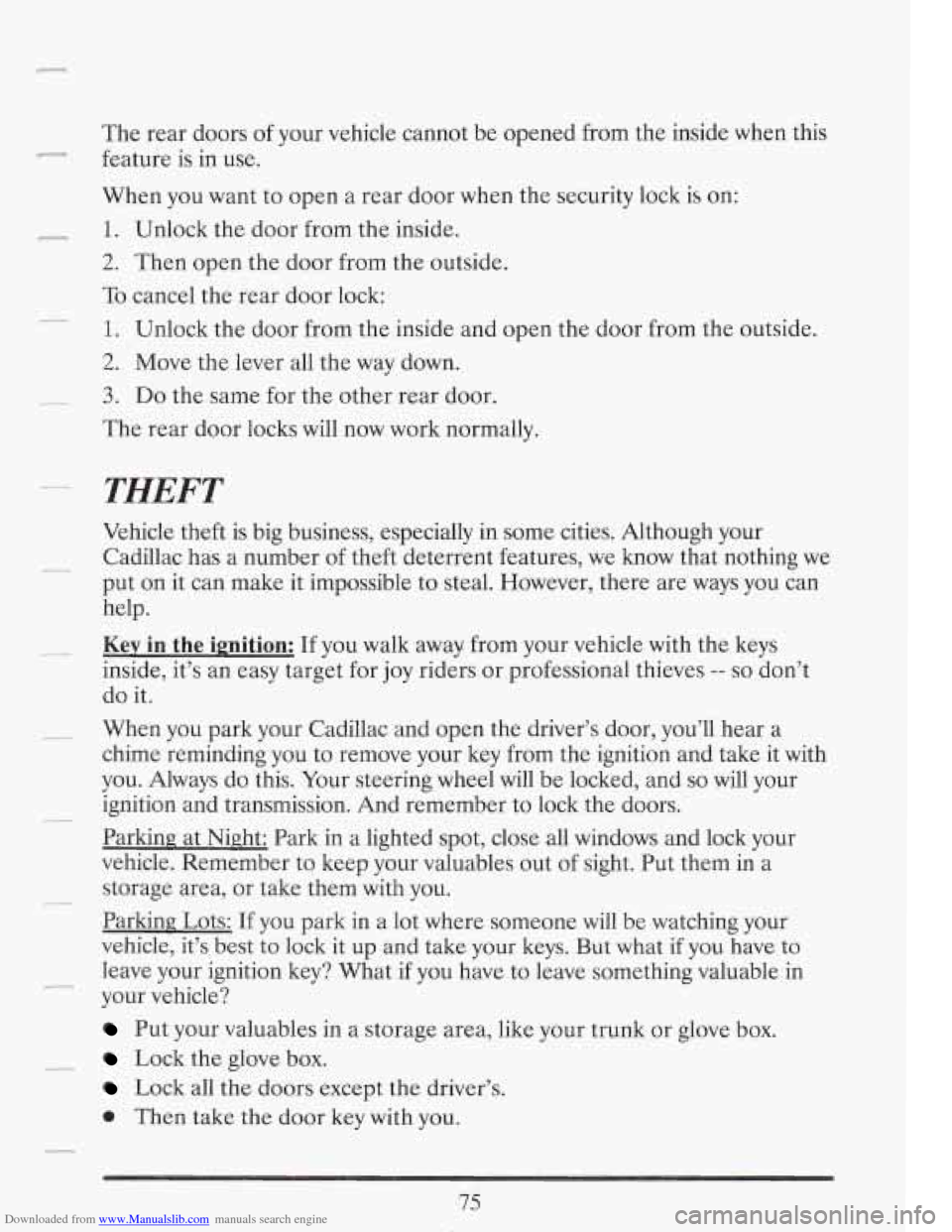
Downloaded from www.Manualslib.com manuals search engine The rear doors of your vehicle cannot be opened from the inside when this
feature is in use.
When you want to open a rear door when the security lock is on:
1. Unlock the door from the inside.
2. Then open the door from the outside.
To cancel the rear door lock:
1. Unlock the door from the inside and open the door from the outside.
2. Move the lever all the way down.
- 3. Do the same for the other rear door.
The rear door locks will now work normally.
THEFT
Vehicle theft is big business, especially in some cities. Although your
Cadillac has a number
of theft deterrent features, we know that nothing we
put on it can make it impossible to steal. However, there are ways you can
help.
Key in the ignition: If you walk away from your vehicle with the keys
inside, it’s an easy target for joy riders or professional thieves
-- so don’t
do it.
When you park your Cadillac and open the driver’s door, you’ll hear a
chime reminding you to remove your key from the ignition and take it with
you. Always do this. Your steering wheel
will be locked, and so will your
ignition and transmission. And remember to lock the doors.
Parking at Night: Park in a lighted spot, close all windows and lock your
vehicle. Remember to keep your valuables out of sight. Put them in a
storage area, or take them with you.
Parking Lots: If you park
in a lot where someone will be watching your
vehicle, it’s best to lock it
up and take your keys. But what if you have to
leave your ignition key? What if you have to leave something valuable in
your vehicle?
Put your valuables in a storage area, like your trunk or glove box.
Lock the glove box.
Lock all the doors except the driver’s.
0 Then take the door key with you.
75
Page 93 of 386
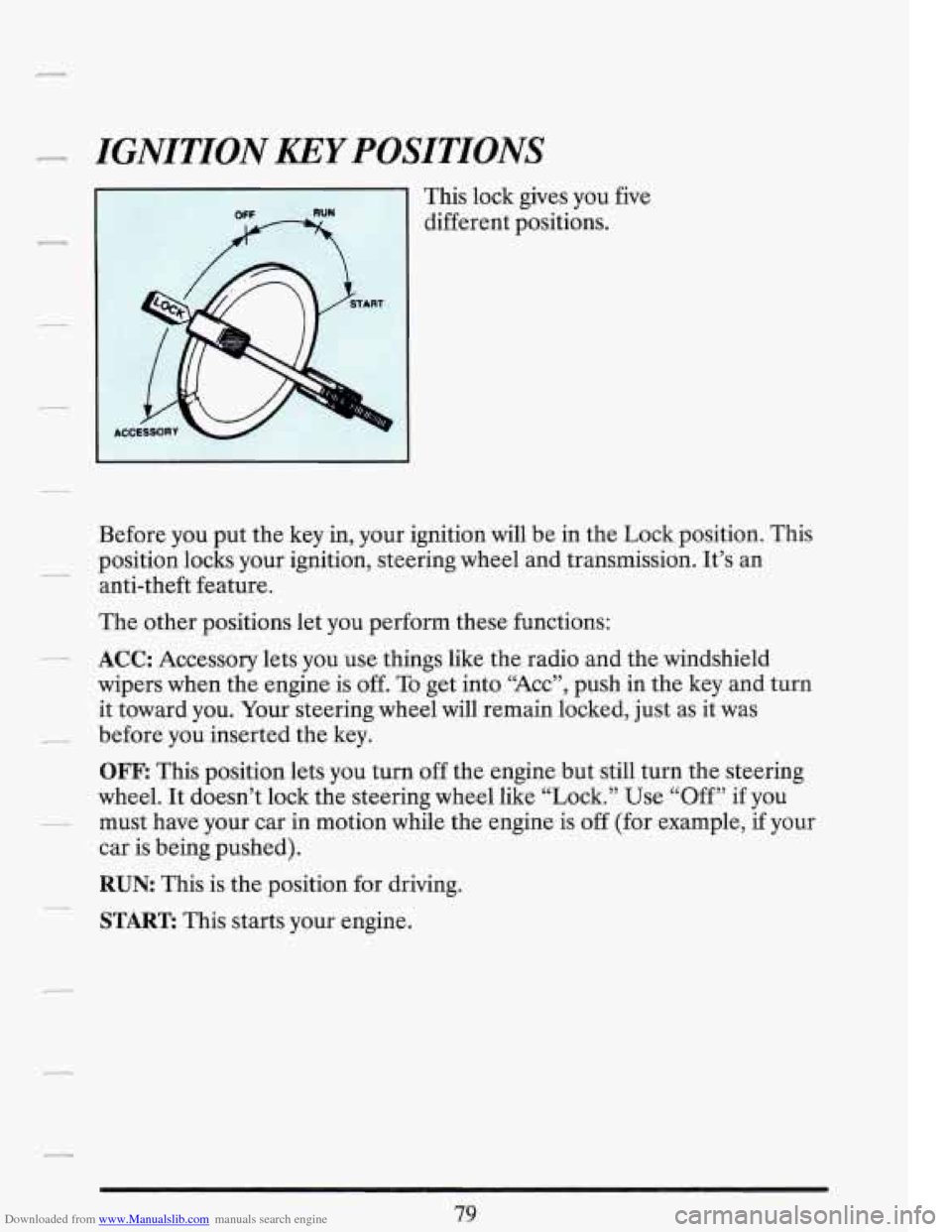
Downloaded from www.Manualslib.com manuals search engine IGNITION KEY POSITIONS
This lock gives you
different positions. five
Before you put the key in, your ignition will be in the Lock position. This
anti-theft feature.
- position locks your ignition, steering wheel and transmission. It’s an
The other positions let you perform these functions:
wipers when the engine is off.
To get into “Acc”, push in the key and turn
it toward you. Your steering wheel will remain locked, just as it was
before you inserted the key.
OFF: This position lets you turn off the engine but still turn the steering
wheel. It doesn’t lock the steering wheel like “Lock.” Use “Off”
if you
car is being pushed).
RUN This is the position for driving.
STARE This starts your engine.
- ACC: Accessory lets you use things like the radio and the windshield
- must have your car in motion while the engine is off (for example, if your
-
79
Page 98 of 386
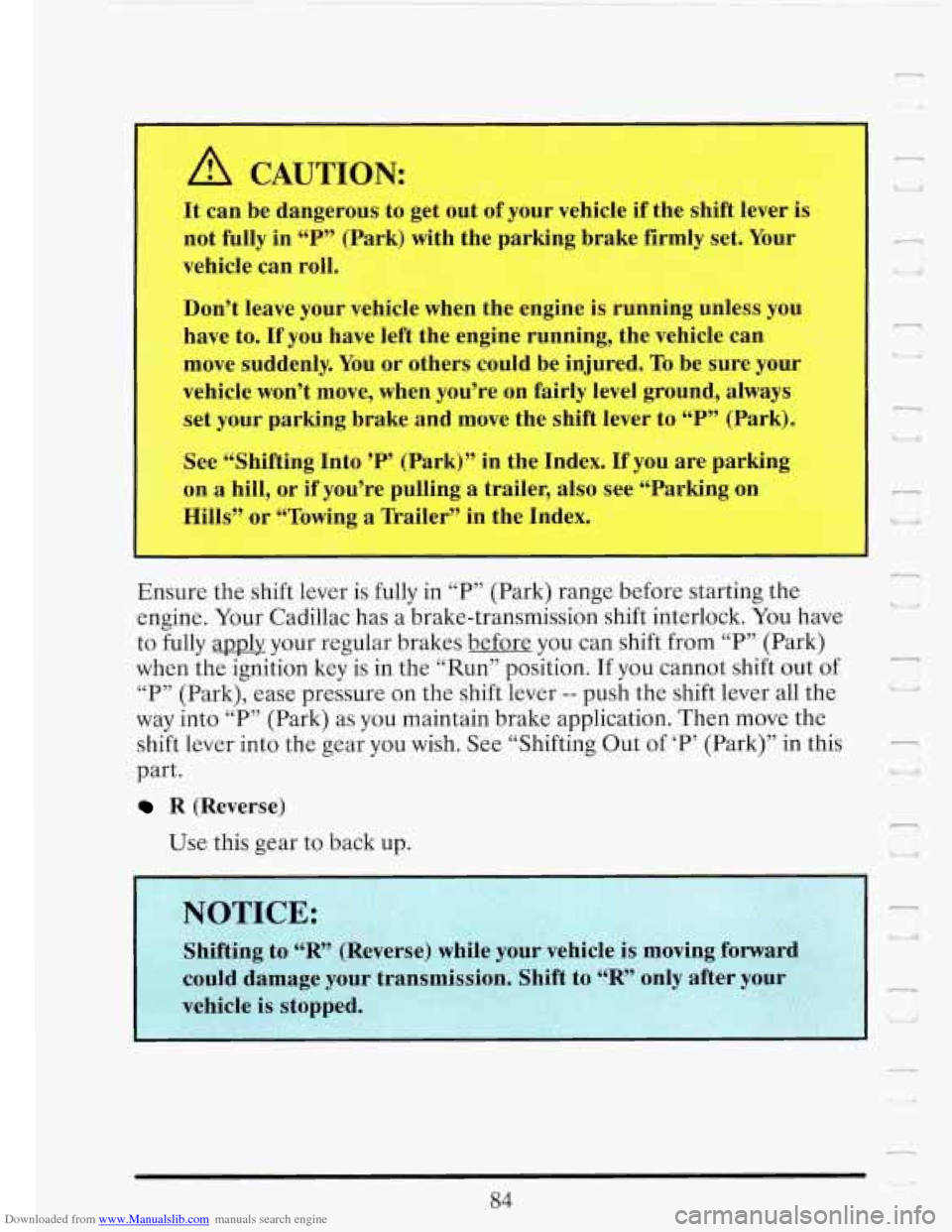
Downloaded from www.Manualslib.com manuals search engine A CAUTION:
It can be dangerous to get out of your vehicle if the shift lever is
not fully
in “P” (Park) with the parking brake firmly set. Your
vehicle can roll.
Don’t leave your vehicle when the engine is running unless
you
have to. If you have left the engine running, the vehicle can
move suddenly. You or others could be injured.
To be sure your
vehicle won’t move, when you’re on fairly level ground,
always
set your parking brake and move the shift lever to “P” (Park).
See “Shifting Into ’P’ (Park)” in the Index. If you are parking
on
a hill, or if you’re pulling a trailer, also see “Parking on
Hills’’ or “Towing a Railer” in the Index.
Ensure the shift lever is fully in “P” (Park) range before starting the
engine. Your Cadillac has a brake-transmission shift interlock. You have
to fully apply your regular brakes before you can shift
from “P” (Park)
when the ignition key
is in the “Run” position. If you cannot shift out of
“P” (Park), ease pressure on the shift lever
-- push the shift lever all the
way into “P” (Park) as you maintain brake application. Then move the
shift lever into the gear you wish. See “Shifting Out of
‘P’ (Park)” in this
part.
R (Reverse)
Use this gear to back up.
I
ha
1 UI
r
.i
I 4
84
‘- I
Page 99 of 386
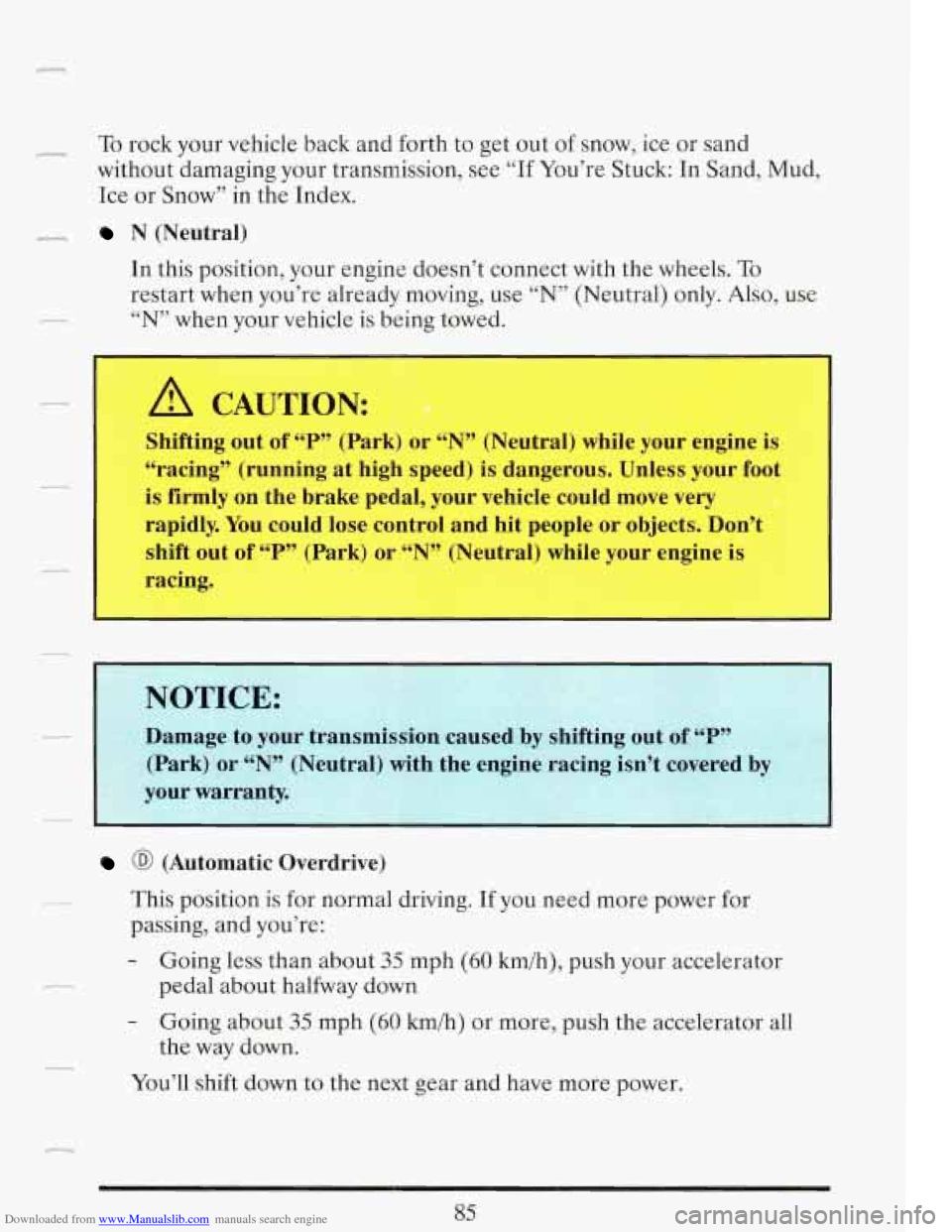
Downloaded from www.Manualslib.com manuals search engine r To rock your vehicle back and forth to get out of snow, ice or sand
without damaging your transmission, see
“If You’re Stuck: In Sand, Mud,
Ice
or Snow” in the Index.
N (Neutral)
In this position, your engine doesn’t connect with the wheels.
To
restart when you’re already moving, use “N” (Neutral) only. Also, use
“N” when your vehicle is being towed.
A CAUTION:
Shifting out of “P” (Park) or “N” (Neutral) while your engine is
“racing” (running at high speed) is dangerous. Unless your foot
is firmly on the brake pedal, your vehicle could move very
rapidly. You could lose control and hit people or objects. Don’t
shift out of
“P” (Park) or “N” (Neutral) while your engine is
racing.
c
c-
r
@ (Automatic Overdrive)
This position is for normal driving.
If you need more power for
passing, and you’re:
- Going less than about 35 mph (60 kmih), push your accelerator
- Going about 35 mph (60 km/h) or more, push the accelerator all
You’ll shift down to the next gear and have more power.
pedal about
halfway down
the way down.
85
Page 100 of 386
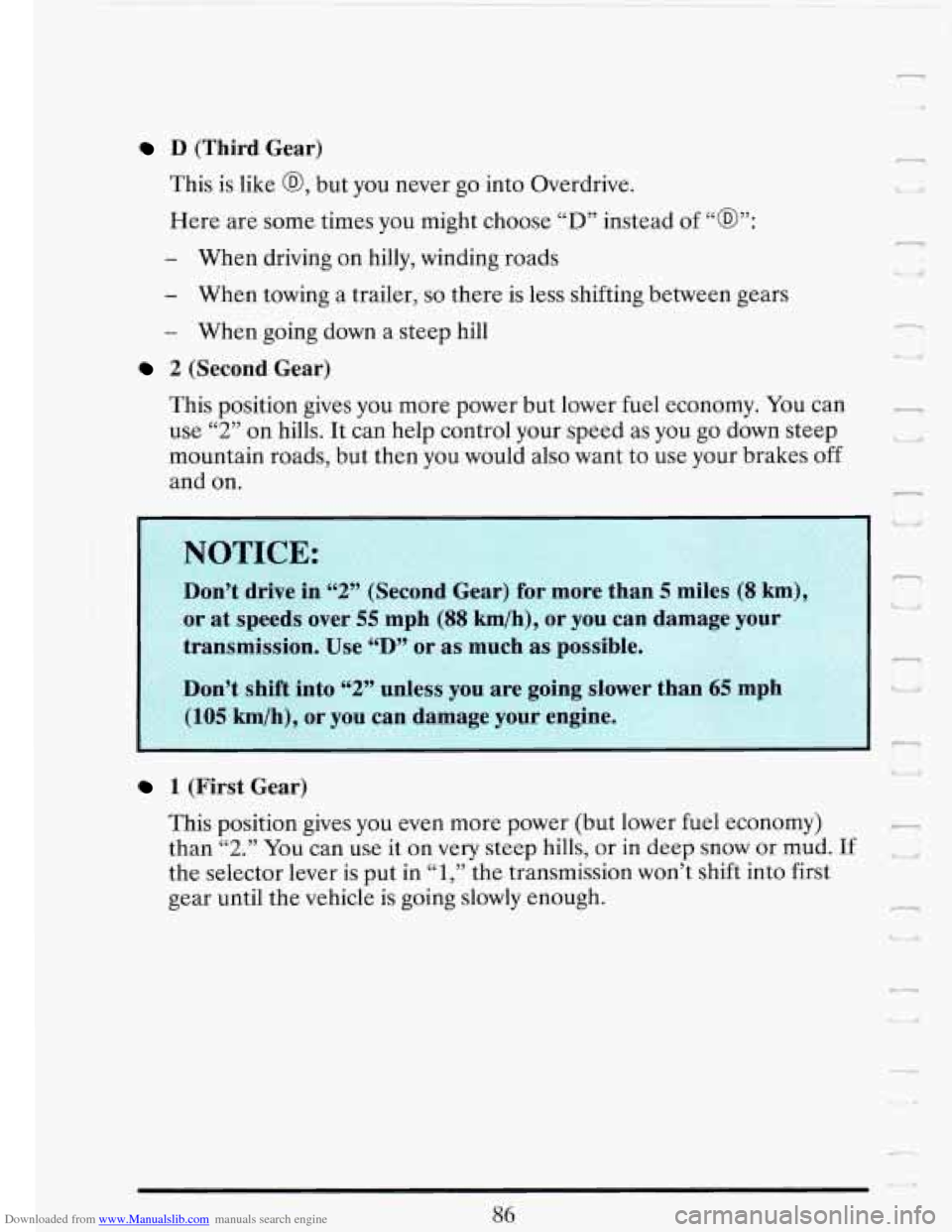
Downloaded from www.Manualslib.com manuals search engine D (Third Gear)
This is like
@, but you never go into Overdrive.
Here are some times you might choose
“D” instead of “a”:
- When driving on hilly, winding roads
- When towing a trailer, so there is less shifting between gears
- When going down a steep hill
2 (Second Gear)
P
bl ia
This position gives you more power but lower fuel economy. You can -
use 2 on hills. It can help control your speed as you go down steep
mountain roads, but then you would also want to use your brakes
off
and on.
cc 97 ,>
NOTICE:
Don’t drive in “2” (Second Gear) for more than 5 miles (8 km),
or at speeds over 55 mph (88 km/h), or you can damage your
transmission. Use “D” or as much
as possible.
Don’t shift into
“2” u are going slower than 65 mph
(105 km/h), or you can damage your engine.
1 (First Gear)
I-
This position gives you even more power (but lower fuel economy) r
than “2.” You can use it on very steep hills, or in deep snow or mud. If I
the selector lever is put in “1,” the transmission won’t shift into first
gear until the vehicle is going slowly enough.
- I,
U
-.
L.
86
Page 101 of 386
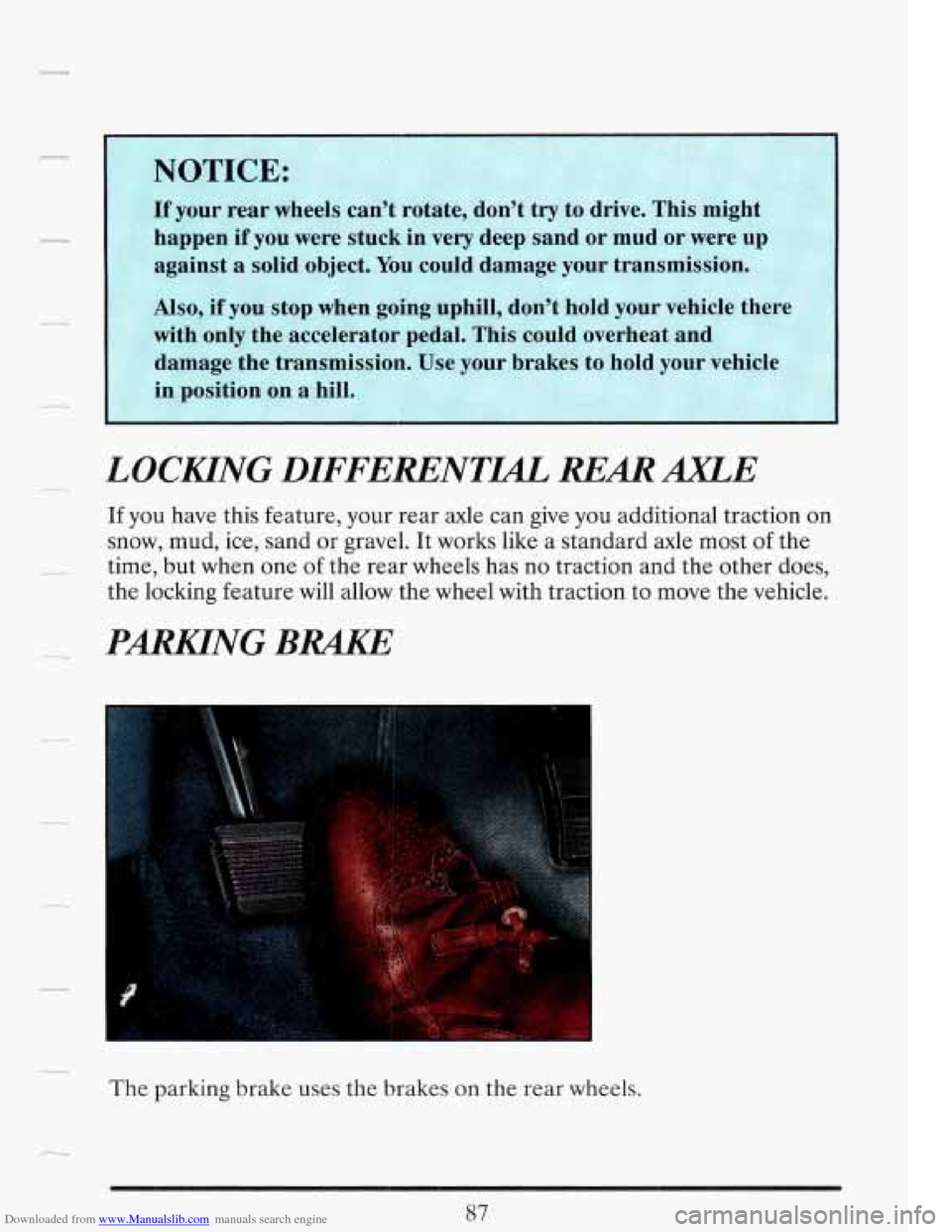
Downloaded from www.Manualslib.com manuals search engine r
NOTICE:
If your rear wheels can’t rotate, don’t try to drive. This might
against
a solid object. You could damage your transmission.
- happen if you were stuck in very deep sand or mud or were up
Also, if you stop when going uphill, don’t hoh’
with only the accelerator pedal. This could
01
damage the transmission. Use your brakes ta
in position on a hill.
I. 1 ..
-
- I
LOCHNG DIFFERENTm REAR AXLE
If you have this feature, your rear axle can give you additional traction on
snow, mud, ice, sand or gravel. It works like a standard axle
most of the
time, but when one
of the rear wheels has no traction and the other does,
the locking feature
will allow the wheel with traction to move the vehicle.
PmNG BRAKE
-
The parking brake uses the brakes on the rear wheels.
Page 105 of 386
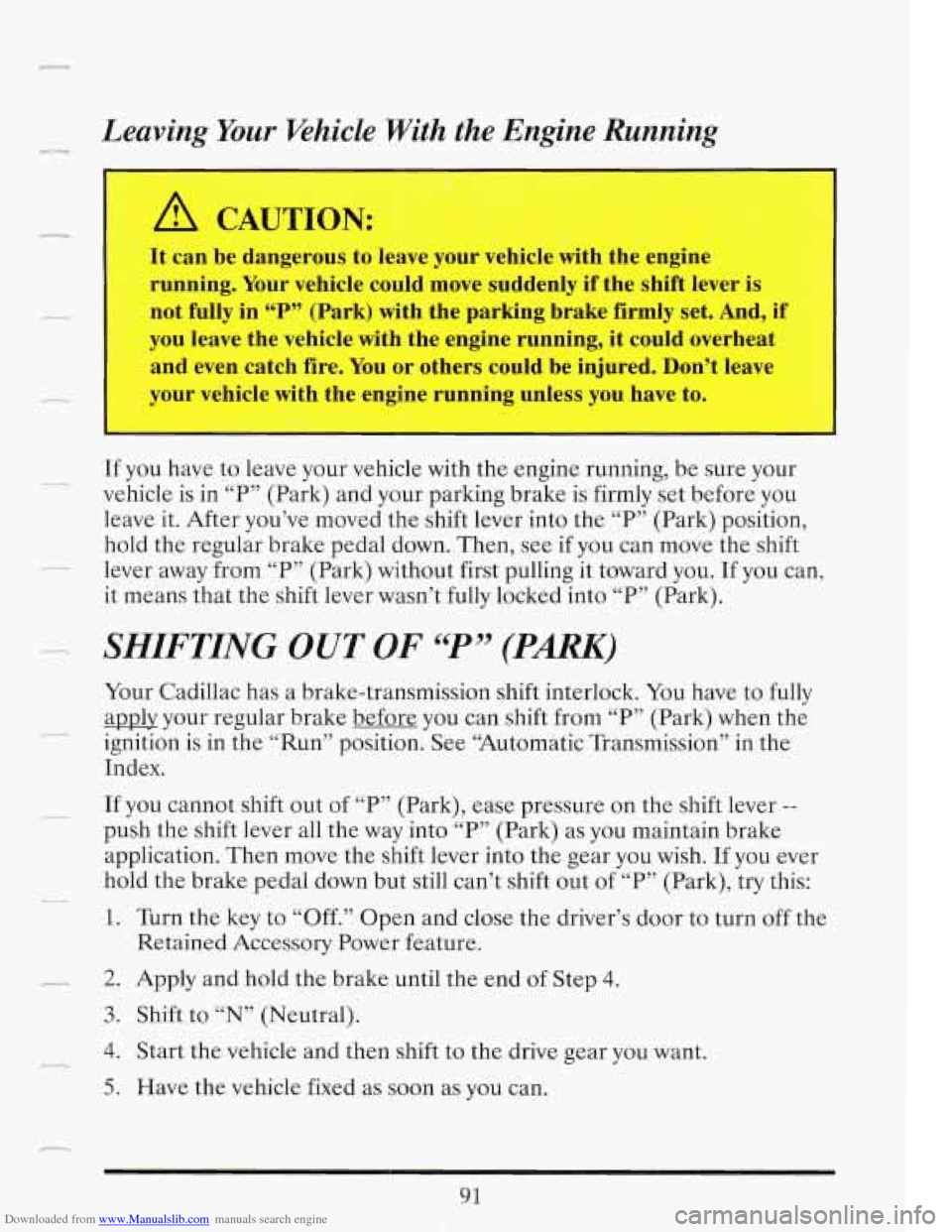
Downloaded from www.Manualslib.com manuals search engine Leaving Your Pkhicle With the Engine Running
----
A CAUTION:
It can be dangerous to leave your vehicle with the engine
running. Your vehicle could move suddenly if the shift lever is
not fully in “P” (Park) with the parking brake firmly set. And, if
you leave the vehicle with the engine running, it could overheat
and even catch fire. You or others could be injured. Don’t leave
your vehicle with the engine running unless you have to.
If you have to leave your vehicle with the engine running, be sure your
vehicle is in “P” (Park) and your parking brake is firmly set before you
leave it. After you’ve moved the shift lever into the “P” (Park) position,
hold the regular brake pedal down. Then, see if you can move the shift
lever away from “P” (Park) without first pulling it toward you. If you can,
it means that the shift lever wasn’t fully locked into “P” (Park).
SHIFTING OUT OF “P” (PARK)
Your Cadillac has a brake-transmission shift interlock. You have to fully
apply your regular brake before you can shift from “P” (Park) when the
ignition is in the “Run” position. See “Automatic Transmission” in the
Index.
If you cannot shift out of “P” (Park), ease pressure on the shift lever --
push the shift lever all the way into “P” (Park) as you maintain brake
application. Then move the shift lever into the gear you wish.
If you ever
hold the brake pedal down but still can’t shift out
of “P” (Park), try this:
1.
2.
3.
4.
5.
Turn the key to “Off.” Open and close the driver’s door to turn off the
Retained Accessory Power feature.
Apply and hold the brake until the end of Step
4.
Shift to “N” (Neutral).
Start the vehicle and then shift to the drive gear you want.
Have the vehicle fixed as
soon as you can.
91